The crucial link to her hair-straightening treatment emerged when she disclosed the use of a straightening cream...
Digital Desk: A recent case published in The New England Journal of Medicine has shed light on the hidden dangers of hair-straightening treatments. The study, while maintaining the anonymity of the patient involved, recounts the harrowing experience of a 26-year-old woman who suffered kidney damage following multiple visits to a salon for a popular hair-straightening procedure.
According to the report, the woman, previously in good health, experienced alarming symptoms after each salon visit in June 2020, April 2021, and July 2022. These symptoms included vomiting, diarrhea, fever, back pain, and a burning sensation on her scalp during the treatment, eventually leading to ulcers on her head.
Medical attention was sought when her condition worsened, revealing kidney malfunction indicated by elevated levels of creatinine in her blood and the presence of blood in her urine. Despite a CT scan showing no signs of infection or blockage in her kidneys, further investigation revealed recurrent episodes of acute kidney injury caused by oxalate nephropathy—a rare disorder attributed to the buildup of calcium oxalate crystals in kidney tubules.
The crucial link to her hair-straightening treatment emerged when she disclosed the use of a straightening cream containing glyoxylic acid—a chemical suspected to have caused scalp burns and subsequent kidney damage. Experimental studies on mice supported the theory that the acid, absorbed through the skin, reached the kidneys and instigated the injury upon breakdown.
Dr. Joshua David King, an associate professor of medicine and pharmacy at the University of Maryland, emphasized the need for regulatory action, advocating for the ban of glyoxylic acid in such products and urging manufacturers to seek safer alternatives.
This case underscores the importance of understanding the potential risks associated with seemingly routine cosmetic procedures. Hair straightening, a practice dating back to the late 19th century, has evolved significantly, yet the dangers posed by certain chemicals remain inadequately addressed.
As consumers, it is imperative to prioritize safety and demand transparency from manufacturers and service providers. Only through increased awareness and regulatory scrutiny can we mitigate the hidden risks lurking behind beauty treatments and safeguard public health.

Leave A Comment